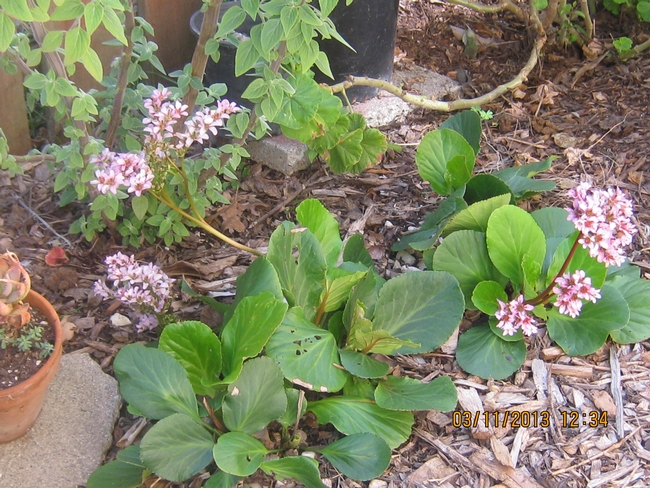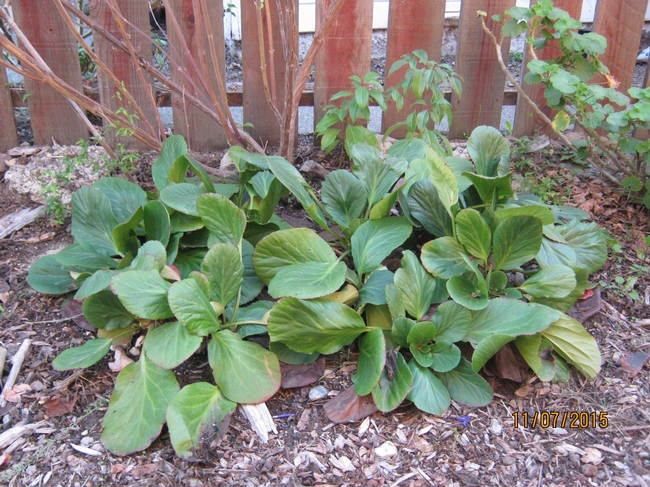- Author: Susan P Croissant
Elephant's Ears, Heartleaf (Bergenia cordifolia, Bergenia crassifolia).
Bergenias, named for the 18th Century German botanist Karl August von Bergen, have been in American and British gardens for at least two centuries. An under-appreciated species, it is a good choice for someone who doesn't know much about gardening. Hardy, reliable, easy care, rewarding results, attractive year round. Almost impossible to kill.
An attractive ground cover, spread by fibrous above-ground sideways stalks. Dark-green, glossy, slick, smooth, round/heart-shaped leaves have a cabbage-like leathery appearance. Sometimes called Pigsqueak (rub leaves for squeaky-clean sound). Most varieties have bell-shaped flowers, compact clusters atop 12-inch burgundy stems. From pale/rosy/deep pink to ruby red, magenta, dark purple. Each flower spike lasts only a few weeks, but the blooming period can be prolonged by regularly removing the spent spikes.
One of winter's most adaptable evergreen perennials. An interesting contrast to other winter plants as cooler weather sees enriching tones in leaf coloring--maroon, crimson, bronze, magenta, beet red, ruddy (red/reddish). This color sometimes lasts until April. Only on occasion do March-May blooms occur together with the winter-maroon leaves.
Siberian Bergenia varieties such as B. cordifolia (Saxifraga), B. crassifolia (Siberian Tea) and their hybrids have the greatest tendency to maroon in colder temperatures. With warm winters, they may stay green year round. B. cordifolia flowers March-May, magenta-pink, short stems. 'Winter Glut' rosy-pink. 'Abendglocken' (Evening Bells) has striking dark lilac-pink on tall stalks. B. crassifolia blooms early December or February-early March, magenta-pink. B. purpurascens (Purple Pigsqueak), mostly in the Midwest/East, produces red-purple leaves in fall/winter, deep-pink/magenta-purple/ red flowers in spring. B. emeiensis is strikingly different. Cliff-dwelling (WA state). Five-petalled white blooms, more daisy-like than the usual hanging-bells, mid-late spring. Not as cold-hardy, it is sometimes offered as a house plant or as a garden variety where summers are too hot for most Bergenias.
Bergenias tolerate drought but prefer moist soil. Suitable for light (sandy), medium (loamy), even clay (heavy) soil. Soil pH neutral, alkaline or acid. Full, semi- or no shade. Full shade produces lighter green, floppier leaves and longer necks trying to reach the sun. Semi-shade retains an attractive appearance that can become extremely green and lush if kept damp. With a little sun, the red effect heightens in bronzy red-leaf varieties. With no shade at all, it may suffer. Full sun, high summer heat and insufficient water burns leaves, plant remains shorter and rusty-looking around the edges. Nonetheless, apt to survive and continue spreading. Mulch lightly and water more in summer. Compost early winter. Nip off old foliage turned brown.
In selecting Bergenia, start with a few adult plants. Youngsters take time to get well-rooted and begin spreading. Choose root-bound in gallon-size pots. Plant in autumn or spring (after blooming) near a shrub, boulder or fence for wind protection, preferably north/northeast side of garden for afternoon shade. Or in a mixed container. After 3-4 years, it may become overcrowded and flower production may decline. Divide in spring after bloom. Deer resistant. Watch for snails, slugs, and weevils.





